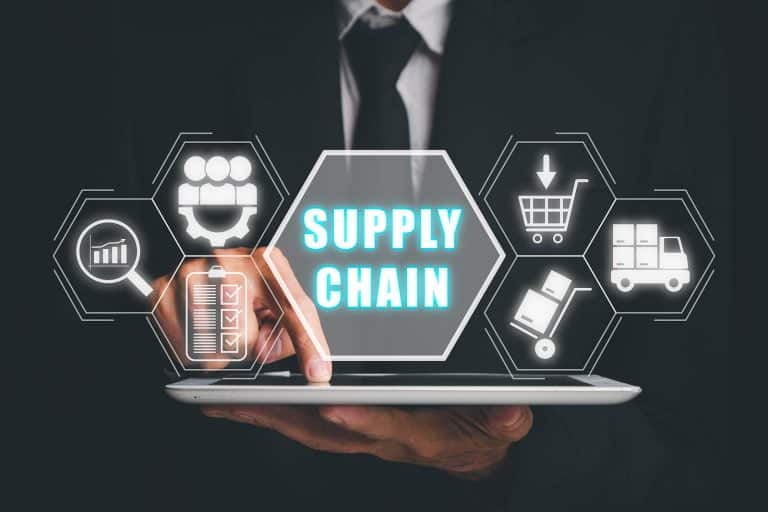For a very good reason, the immutable ledger technology, blockchain, is rising as a promising technology in various industry sectors. This ledger staggeringly improves various industries with decentralized, scalable, transparent operations that boost growth, reduce loss, and maximize customer satisfaction.
Table of Contents
ToggleConsidering these advantages, many businesses are availing blockchain development services to reform their business processes and operations, market, supply chain, consumer and business-to-business services, and other specific industry aspects. Let’s dive deep and learn more about blockchain technology, its technical details, and how it benefits business operations.
What is Blockchain?
Simply put, it is a ledger of securely shared decentralized data. This data is nothing but transaction details broken down into shared blocks connected with unique identifiers in the form of cryptographic hashes.
Since this immutable ledger works on a P2P network, anyone can see the transaction history of any party without altering the details, which increases transparency and trust in the technology.
Unlike traditional trading, where middle parties such as institutions and banks verify the transaction for successful exchange, blockchain takes a technological approach with the use of smart contracts and equations that require computational power to automate and validate exchange. It means they do not report to any government party or central authority to operate.
Multiple sectors have used this technology for the past few years. For instance, more than 90% of banks in the US and Europe were already using blockchain-based projects before 2018.
As per the current technology status, CoinJournal Report pointed out that blockchains could help reduce up to 30% of banking infrastructure costs in the financial sectors.
The construction sector is also keenly adapting to blockchain’s agile functionalities. A 2017 study by Mckinsey revealed that blockchain technology could give the industry a productivity boost of up to 9%, with 7% in cost reduction.
The travel and mobility sector has also seen positive impacts, such as a cost reduction of 20% in consumer ticket booking.
Other sectors have experienced similar results with blockchain’s pseudo-anonymous characteristics, greater transparency, and automated operations.
How it Works
The exchange process on a blockchain follows two different keys, public and private. This gives the participating user his unique identity to make an exchange. The public key locates a user, whereas the private key allows users to transact cryptos or other digital collectibles using their public key.
So if one party wants to withdraw or transact a specific crypto amount, their wallet address will be the public key, and by using the private key, they can exchange with the other party using their wallet.
Consider an exchange where A wants to transact cryptocurrencies into B’s wallet. Then it will include B’s wallet address, i.e., the public key to locating his ID, and A’s wallet address (public) and private keys to encrypt and proceed with the transaction.
Once the transaction is processed, blockchain nodes verify the transaction, and the ledger gets updated with a unique ID and time frame.
The Five Layers of Blockchain
Blockchain development is a tedious process that comprises five layers. These affect how the blockchain functions as a whole. To guarantee seamless service delivery through the blockchain network, each layer operates with a specific purpose and a specific tech stack.
Hardware Layer
The base layer that supports the entire tech stack and blockchain is the hardware layer. It comprises multiple networks from hardware such as IoT, mobile devices, computers, and other devices to form nodes responsible for all data transmission and packetization.
Data Layer
The data layer comprises all the details of transactions that have happened, such as the details of public and private keys and the cryptocurrency sent to the receiver.
Network Layer
In the network layer, the nodes communicate over a blockchain to learn about ongoing transactions and details on what other nodes are participating in the validation process.
Consensus Layer
This layer adds a special mathematical conundrum or equation to validate the blocks. These are solved by different consensus mechanisms used by different blockchains such as PoW, PoS, and others. On validation of the transaction, the block is added to the blockchain.
Application Layer
The application layer is the topmost layer where various types of applications are deployed. These include decentralized apps (DApps), crypto wallets, services, decentralized finance applications (DeFi), and the NFT marketplace.
The Different Types of Blockchain
Businesses rely on capable blockchain development services to get the right type of blockchain for their operations. Based on blockchain use cases, they can be categorized into private, public, and federated. Each possesses traits for different operations and provides unique functionalities to execute exchanges.
Public Blockchains
As the name suggests, the public blockchain network is publicly available for everyone who wants to securely trade digital collectibles, cryptos, or other data without relying on the government-controlled central authority.
However, the network uses rules and consensus mechanisms to conduct end-to-end transactions. Bitcoin, Ethereum, and Litecoin are public blockchain networks anyone can access.
Federated or Consortium Blockchains
Federated blockchains are also known as consortium blockchains and are generally used by leaders.
As it is built for enterprises, not everyone gets to participate in the blockchain, and not everyone can read the transaction history. These have exceptional privacy, scalability, speed, and security.
The consensus mechanism of these blockchains is closely controlled either by preselected nodes or preselected leaders/stakeholders.
Permissioned or Private Blockchains
Unlike Federated blockchains, private blockchains are controlled by private bodies. The only difference here is that private blockchains are controlled by a single person and not by a group of leaders.
Only users and companies with access can access the specific data set. If the user or company doesn’t have access, they must request permission to enter and access the required dataset.
What Can Blockchains do for Businesses
The technology has the potential to improve the way businesses operate significantly. It can even reform the business model, reduce unnecessary spending, and increase efficiency to grab maximum profits. Following are some other benefits that businesses can get from blockchain technology.
Simultaneous Record-Keeping and Validation
The network keeps track of every transaction record that has happened (recording actions) along with its validation (ensuring the transaction record is a valid representation) to reduce cost and achieve efficiency.
P2P Transactions
The technology helps businesses make transactions without the hindrance of a third party or central authority for seamless and secure exchange that guarantees trust.
Re-engineering of Business Processes
The blockchains introduce methods to re-engineer business processes for transformation and eliminate trust issues among stakeholders with decentralized, immutable, traceable data and its business logic.
Automation
Blockchains automate business processes with smart contracts (a mechanism that automatically checks and executes exchange when specified conditions are met) and business logic resulting in seamless transactions.
Cost Cutting
The transactions on blockchains are done automatically without any third party’s help, reducing the time and costs to make an exchange. Moreover, the verification and validation process is done simultaneously, preventing businesses from spending extra.
Limitations
Every technology has a possible limitation that makes it slightly unreliable. Blockchain has these too, such as its scalability concerns due to complex validation and high energy consumption due to high computational power requirements.
On top of it, some might find its implementation in legacy systems complex and private key issues to be a concern as they might get stolen, jeopardizing crucial data and finances.
Final Words
Blockchain is a revolution in the technology space that has the potential to transform the world with its unique decentralized characteristics. Multiple sectors are already adapting these solutions to make industry-specific processes easy, reliable, quick, transparent, and secure. However, its successful implementation may require consideration of its limitations, understanding all technological parameters by participating parties, and aligning its functionality for business use cases.




